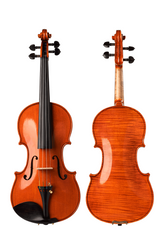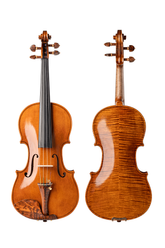The most complete guide to violin rosin in 2023
Your bow must use rosin to make the violin sound nice. Rosin is also an essential accessory for violinists and string players. So have you learned about rosin in detail? Don't worry, this article will bring you the most comprehensive rosin knowledge.
What is Rosin?
Rosin is a sticky substance made of resin, which is mostly used in stringed instruments to apply to bowstrings to increase grip. According to the sources of raw materials and processing methods, it can be divided into gum rosin, wood rosin, and tall oil rosin.

Gum rosin: The rosin that is collected by ripping the tree surface and then refined through processing is called gum rosin. China is rich in rosin resources and is the world's largest producer of gum rosin. Gum rosin is also the most environmentally friendly and sustainable natural resource, and the annual production of gum rosin accounts for about 60%-65% of the total rosin output.
Wood rosin: The root or trunk of the pine tree is chopped up, soaked in a solvent to extract the resin, and finally refined and processed. The main place of production is the United States, and the raw materials come from the original pine forests in the southeastern United States. Due to the need to protect forest resources, this type of rosin is very rare, accounting for about 5% of the total rosin output.
Tall oil rosin: from the pulp and paper industry, from which rosin is processed and extracted. But now that the industry has reduced the use of pine wood, the annual output of tall oil rosin has also decreased, accounting for about 30%-35% of the total rosin output.
As a violinist, why use rosin?
In the article How does your violin produce sound, I introduced in detail how the violin produces sound. So simply speaking, the sound is finally produced by the vibration of the bowstring and the string. But if you receive a new bow, you will find that there is almost no way to make a sound, it is because you have not rubbed the new bow with rosin. The role of the rosin is to increase the stickiness of the bow so that it can grip the strings and vibrate.
Types of violin rosin
If you are a violin beginner, you will find that rosin has a lot of colors and shades when purchasing rosin. Don't worry, simply speaking, it can be divided into light rosin and dark rosin.
Light rosin has a relatively hard texture and low viscosity, which is suitable for hot and humid weather in summer. Generally, violins and violas will be more suitable.
Dark rosin has a soft texture and high viscosity, which is suitable for cold and dry weather in winter. Generally, cellos and basses will be more suitable.
Special Rosin:
1: Some rosins are also called dust-free rosins due to less dust.
2: In order to facilitate the use of rosin for people who are allergic to rosin, there is a kind of rosin called hypoallergenic rosin (not rosin made from rosin).
3: Rosins are added with other metal powders, such as gold powder rosin, silver powder rosin, lead powder rosin, and copper powder rosin.
Gold powder rosin: It will help the strings to produce a warm, clear, and distinct sound, which is very suitable for all kinds of stringed instruments.
Silver powder rosin: It can make the strings produce a concentrated and bright sound, which is more suitable for violin and viola.
Lead powder rosin: soft but not sticky, mild and clear pronunciation, suitable for violin and viola.
Copper Powder Rosin: Good for beginners as it is easy to play and produces a warm and soft sound.
How to choose rosin?
For the selection of rosin, the most important thing is to consider three aspects, viscosity, dust, and durability.
The viscosity of rosin: Don't think that the higher viscosity is better, the viscosity should be suitable for your situation. In the case of violins and violas, excessive viscosity tends to make noise, and it will be more difficult to make timbre changes. At the same time, the over-sticky rosin also easy to forms small pieces on the bowstring, which affects the vibration. At this time, some students will choose to continue wiping the rosin to increase the bite force. This is actually wrong, just remove excess rosin from the bowstring in time. For cellos and basses, viscous rosin is required. This is because their strings have greater tension and require more friction to pull the strings apart.
Dust of Rosin: Rosin with less dust will be more comfortable. The rosin used by many beginners will cause smoke and dust to fly when playing, which is often caused by wiping too much rosin or too much rosin dust. This is not good for the health of the player itself and the protection of the violin, and the floating dust will also affect the player's performance experience. So it is recommended to use dust-free rosin.
The durability of rosin: Many people ignore this angle, which is a factor that needs to be considered. After some rosin is wiped, the sound is very good at first, but it will not work after a while, and the bow needs to be re-applied with rosin. This is very troublesome.
In the end, as long as your rosin gives you smooth, supple, loud, and well-controlled playing, then this is the best rosin for you. There is no need to spend too much energy on the choice of rosin, especially for beginners or students. Although rosin has a certain impact on the tone, it is difficult for beginners or students to understand the difference.
How to rub rosin on a bow?
To apply rosin to a bow for a string instrument such as a violin, viola, cello, or bass, you should first make sure the bow hair is clean and dry. Then, take a small amount of rosin and hold it against the bow hair near the frog (the part of the bow that is closest to the handle). Gently rub the bow back and forth across the rosin, making sure to apply the rosin evenly across the entire length of the bow hair. Be sure to pay special attention to the middle of the bow, as this is where the bow hair is typically used the most. You can check the progress and evenness of the application by visually inspecting the bow hair, and by playing the instrument and listening for a clear and even sound.
Note: When using rosin for the first time, use scissors or a hard object to scratch the surface of the rosin. (be safe)
After use, you need to pay attention to the matters needing attention
1: Use a cloth to wipe off the rosin powder on the violin to prevent the rosin from damaging the violin. Do not use solvents such as alcohol to wipe, otherwise, it will damage the violin varnish.
2: After each use, the rosin on the strings needs to be wiped off.
3: Check the bow. When there is too much rosin, you can use your fingers to flick the bowstring close to the frog and remove the excess rosin on the bowstring through vibration.
4: Rosin dust mixed with air is relatively flammable, so be careful to keep away from open flames when wiping rosin or rosin smoke.
Protect your rosin
Rosin is very brittle and will break easily, so it can be wrapped with cloth and put in the piano case when not in use. In addition, rosin is also sensitive to temperature changes, and it is recommended to store it at room temperature.
Rosin recommended by Fiddlover Violin Shop
Best Violin Rosin for Beginners: Low Dust Natural Rosin R005

The beautiful rosin is wrapped with a soft cloth, which can have a dust-free playing experience while being moderately viscous. The price is also more appropriate, you can have it for $19.
Follow Fiddlover to learn more about the violin.
FAQs
Question: How often should the rosin be replaced?
Answer: Generally speaking, rosin has no shelf life, as long as you have no problems when using it, you can continue to use it. Professional players will replace the rosin about once a year.
Question: How often do I need to rub rosin on the bow?
Answer: The frequency at which you need to apply rosin to your violin bow depends on a few factors, including how often you play and how dry the climate is where you live. In general, you should apply rosin to your bow whenever you start to notice that it is slipping or not making a sound when you play.
Question: What should I do if the rosin is broken?
Answer: Crushed rosin blocks can also be used, but you need to be careful not to spread the rosin powder elsewhere. (It is not recommended to reshape the rosin by heating yourself, as this is somewhat dangerous)
Question: Is rosin poisonous?
Answer: Generally speaking, it is non-toxic, or does not cause much harm. But if you accidentally eat a lot of rosins, you still need to go to the hospital for an examination in time.
Question: How can I tell if the rosin for my bow is right?
Answer: This needs to be clearer after use. Generally speaking, you need to practice for 2-3 minutes after wiping the rosin, and then feel whether you can achieve the desired effect. If it is too much, remove the excess rosin, and if you feel too little, wipe some more rosin. Ultimately you need to feel smooth, supple, loud, and in control, and then that's it.





